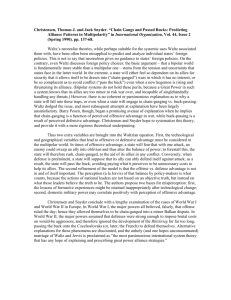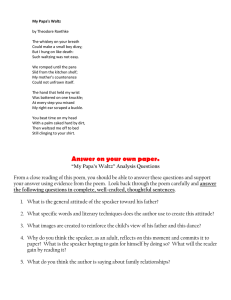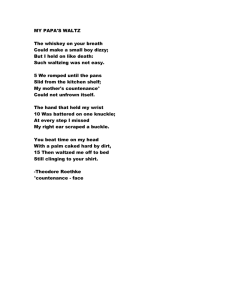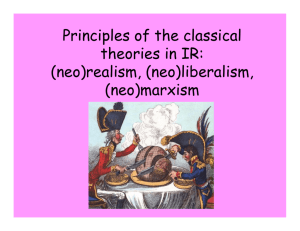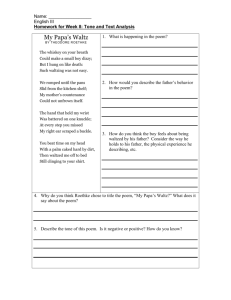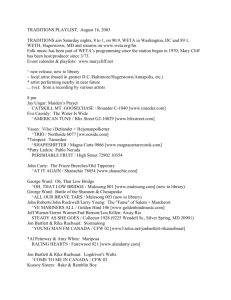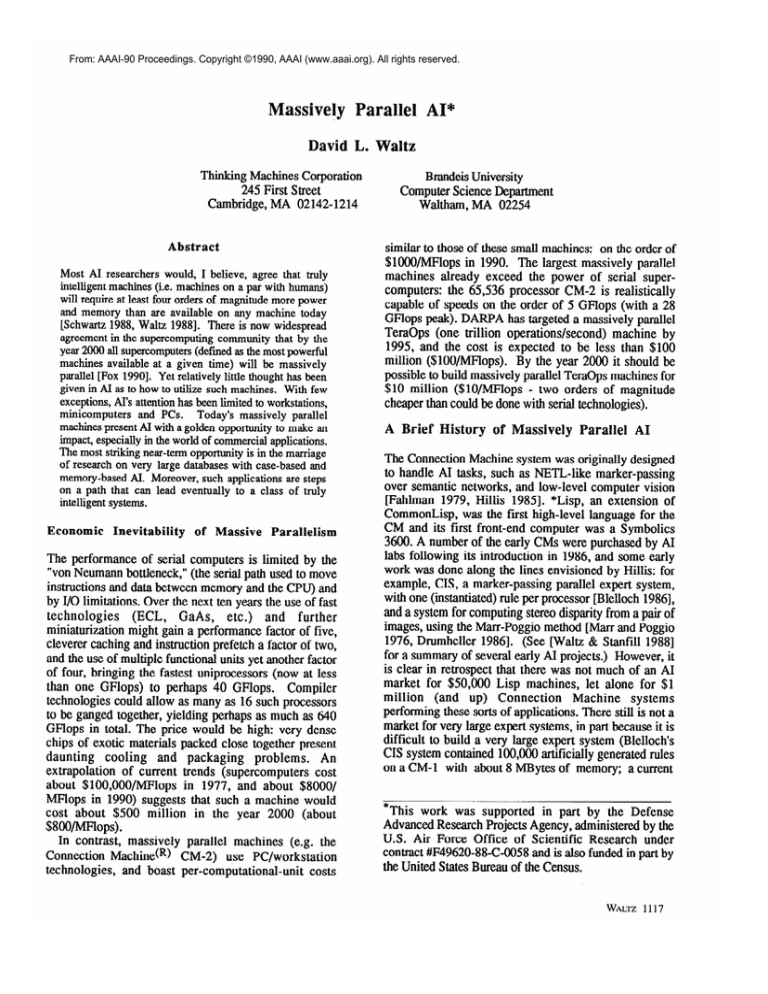
From: AAAI-90 Proceedings. Copyright ©1990, AAAI (www.aaai.org). All rights reserved.
Massively
Parallel AI*
David L. Waltz
Thinking Machines Corporation
245 First Street
Cambridge, MA 02142-1214
Abstract
Most AI researchers would, I believe, agree that truly
intelligent machines (i.e. machines on a par with humans)
will require at least four orders of magnitude more power
and memory than are available on any machine today
[Schwartz 1988, Waltz 19881. There is now widespread
agreement in the supercomputing community that by the
year 2000 all supercomputers (defined as the most powerful
machines available at a given time) will be massively
parallel [Fox 19901. Yet relatively little thought has been
given in AI as to how to utilize such machines. With few
exceptions, AI’s attention has been limited to workstations,
minicomputers and PCs.
Today’s massively parallel
machines present AI with a golden opportunity to make an
impact, especially in the world of commercial applications.
The most striking near-term opportunity is in the marriage
of research on very large databases with case-based and
memory-based AI. Moreover, such applications are steps
on a path that can lead eventually to a class of truly
intelligent systems.
Economic
Inevitability
of Massive
Parallelism
The performance of serial computers is limited by the
“van Neumann bottleneck,” (the serial path used to move
instructions and data between memory and the CPU) and
by I/G limitations. Over the next ten years the use of fast
technologies
(ECL, GaAs,
etc.) and further
miniaturization might gain a performance factor of five,
cleverer caching and instruction prefetch a factor of two,
and the use of multiple functional units yet another factor
of four, bringing the fastest uniprocessors (now at less
than one GFlops) to perhaps 40 GFlops. Compiler
technologies could allow as many as 16 such processors
to be ganged together, yielding perhaps as much as 640
GFlops in total. The price would be high: very dense
chips of exotic materials packed close together present
daunting cooling and packaging
problems.
An
extrapolation of current trends (supercomputers cost
about $1OO,OOO/MFlops in 1977, and about $SOOO/
MFlops in 1990) suggests that such a machine would
cost about $500 million in the year 2000 (about
$8OO/MFlops).
In contrast, massively parallel machines (e.g. the
Connection Machine(R) CM-2) use PC/workstation
technologies, and boast per-computational-unit
costs
Brandeis University
Computer Science Department
Waltham, MA 02254
similar to those of these small machines: on the order of
$lOOQ/MFlops in 1990. The largest massively parallel
machines already exceed the power of serial supercomputers: the 65,536 processor CM-2 is realistically
capable of speeds on the order of 5 GFlops (with a 28
GFlops peak). DARPA has targeted a massively parallel
TeraOps (one trillion operations/second) machine by
1995, and the cost is expected to be less than $100
million ($lOO/MFlops). By the year 2000 it should be
possible to build massively parallel TeraOps machines for
$10 million ($lO/MFlops - two orders of magnitude
cheaper than could be done with serial technologies).
A Brief History
of Massively
Parallel
AI
The Connection Machine system was originally designed
to handle AI tasks, such as NETL-like marker-passing
over semantic networks, and low-level computer vision
[Fahlman 1979, Hillis 19851. *Lisp, an extension of
CommonLisp, was the first high-level language for the
CM and its first front-end computer was a Symbolics
3600. A number of the early CMs were purchased by AI
labs following its introduction in 1986, and some early
work was done along the lines envisioned by Hillis: for
example, CIS, a marker-passing parallel expert system,
with one (instantiated) rule per processor [Blelloch 19861,
and a system for computing stereo disparity from a pair of
images, using the Mar-r-Poggio method [Marr and Poggio
1976, Drumheller 19861. (See waltz & Stanfill 19881
for a summary of several early AI projects.) However, it
is clear in retrospect that there was not much of an AI
market for $50,000 Lisp machines, let alone for $1
million (and up) Connection
Machine systems
performing these sorts of applications. There still is not a
market for very large expert systems, in part because it is
difficult to build a very large expert system (Blelloch’s
CIS system contained 100,000 artificially generated rules
on a CM-l with about 8 MBytes of memory; a current
*This work was supported in part by the Defense
Advanced Research Projects Agency, administered by the
U.S. Air Force Office of Scientific Research under
contract #F49620-88-C-0058 and is also funded in part by
the United States Bureau of the Census.
WALTZ
1117
CM-2 with 8 GBytes of memory could store 100 million
rules!). Likewise, there was not (and still is not) a market
for high volume low-level image processing (although
the new Land&s may eventually create one).
Fortunately for Thinking Machines, the CM-2, with
its floating point option (using up to 2000 Weitek
chips), proved to be an excellent match for a wide range
of scientific problems: finite element models, operations
on large matrices, fluid flow and aerodynamics models, nbody problems (e.g. galactic collisions), interactive
scientific visualization, models using cellular automata,
seismic data processing, signal processing, etc. Most of
Thinking Machines’ sales growth -- 50% per year over the
past four years -- has been fueled by sales for these types
of applications.
But the AI dream is still valid. Recent research using
novel AI paradigms on real customer problems and real
customer databases have identified
some great
opportunities.
The Large-Scale
Commercial
AI Opportunity
Data is being generated faster than it can be digested. Very
large (>lOO GByte) databases are becoming common.
Such databases contain valuable information on customer
credit and buying behavior; many forms of text: public
text, including books, newspapers and news wires,
financial journals, technical industry publications,
scientific journals, and annual reports; and private text,
such as studies,
memos, manuals,
proposals,
documentation; visually oriented materials, including
maps, schematics, plans and blueprints, as well as fastexpanding video archives; and much more.
Until recently mainframe computers, with their
extensive existing software libraries, have been the only
choice for those who own and/or wish to mine such
databases. But mainframes are pitifully slow and at the
same time very expensive, and the software available for
database tasks has been quite primitive because answering
even primitive questions takes too long. Massively
parallel machines offer large storage capacity1 and high
I/O rates, using parallel disk arrays and multiple wideword I/O channels. The total CM-2 I/O capacity is
currently 200 MBytes/second, limited by the disk rates.2
This means that an entire 100 GByte database can be
streamed into the CM-2 in 500 seconds. We estimate
based on preliminary but realistic tests, that we can
achieve a speedups of at least an order of magnitude over
identical data selection operations on a mainframe on a
CM-2 costing only a fraction of the price. [Stanfill,
forthcoming].
This kind of performance opens the possibility for
changing the fundamental nature of an organization’s use
of a database -- from a weekly to a daily batch run, or
from batch to interactive -- and also opens the
opportunity for applying dramatically more complex and
intelligent processing to each database item than can
1118 INVITEDTALK~ANDPA~L~
otherwise be imagined today. In the next several sections,
I outline the algorithms and performance for several
commercially important applications.
Text-based
Intelligent
Systems
For most of its history, AI has been concerned with “toy
problems.” Scaling up presents difficulties: At the two
extremes of the spectrum, one can hand-code (as in CYC
[Lenat et al. 1986]), or one can use methods to
automatically build NLP systems. To date there have
been very few practical applications of natural language
processing, and this fact has dampened the enthusiasm of
funding agencies and companies that support research in
this area. Fortunately, there are signs that this situation
can be improved by strategically merging AI/NLP and
Information Retrieval (IR) technologies.
This offers
novel opportunities both for learning research, and for
building systems that have immediate practical value.
A series of experiments and discoveries led researchers
at Thinking Machines, most notably Craig Stanfill and
Brewster Kahle, to devise a document retrieval system
that works in parallel on the Connection Machine
[Stanfill & Kahle 1986; Stanfill 19881. The resulting
system, marketed as DowQuestcR) by Dow Jones has
been in commercial use since January 1989. DowQuest
provides a high quality search through a clever interface
that can be used effectively by a computer-naive person
after only about 5 minutes of training. The basic idea is
this: A database of documents (e.g. news articles,
abstracts, books, etc.) is distributed to each of the 65,536
processors of a CM-2 (if documents are 2K bytes long,
each processor equipped with large memory can hold
about 256 compressed documents or 16 million total!).
The user types a few words (a question, description, or
list of terms will do) and a carriage return; the terms are
broadcast to all the processors in parallel along with a
numerical “weight” indicating the importance of each
term? The search portion of this operation is analogous
to the following situation: imagine a stadium with
65,536 people, each with one document and a pocket
‘A single current Connection Machine CM-2 can be
equipped with up to eight I/O channels, each of which can
have 16 drops, allowing 15 DataVault disk arrays of up to
80 GBytes each, for a total storage capacity of 8x15~80
GBytes = 9,600 GBytes!
2The CM-2 itself
MBytes/second.
can
handle
more
than
400
3Term weights are assigned automatically by a program
that pre-processes the text and updates the database. The
number of occurrences of each term is saved, and weights
computed proportional to the negative log of the
probability of occurrences of each term.
calculator; an announcer reads each search term followed
by a number (representing the importance of a term (the
rarer a term, the higher its weight) and each person whose
document contains the term adds the score to the
calculator. After all terms are read, the persons with the
highest scored documents present themselves.
(This
would be hard in the stadium analogy). (To match the
real situation, we would actually need either 16 million
people, or 256 documents and 256 calculators per person.)
The headlines for the documents with the highest total
scores are then sent to the user. The user can view the
text of each of these documents by clicking a mouse
while pointing to the headline. When a user sees a
document (or paragraph of a document) that answers
his/her request, the user can mark the document “good” by
pointing and clicking the mouse. The system collects all
the terms from all the documents marked “good” along
with all the initial words the user typed, and repeats the
search process described above, but now using all these
terms. Each search requires less than a second, even on
databases up to 10 GBytes.
This method, called
“relevance feedback” [Salton 19721, generally produces a
substantially better search than is possible with Boolean
search systems [Blair $ Maron 19861.
DowQuest
DowQuest uses the method above, with
enough memory so that a 1 GByte database is
permanently stored. The 16 documents with the best
scores are returned to the user, who can look at the full
text (stored on a disk on the front end server) and can
mark any document (or paragraph of a document) as
“relevant”. DowQuest has about six months worth of
articles from nearly 300 different sources: Wall Street
Journal, Washington Post Barrons, the business sections
of about 100 U.S. newspapers, Fortune. Forbes, and
other magazines, and a number of trade publications (e.g.
Byte). Ninety-nine percent of all searches take under 1.5
seconds, including front end time. CM time for 100
terms is about 170 msec. The system also parses input
text, creates a new surrogate database, and updates the
database while the system is operating on-line.
We have recently outlined algorithms that allow allow
interactive access to 1 TeraByte (I,OOO,OOO
MBytes) of
text [Stanfill, Thau & Waltz 19891. For reference, the
Library of Congress probably contains on the order of 40
Terabytes of text.
New Text Opportunities
This system suggests interesting opportunities
exploiting natural language processing results:
for
Adding NLP It is highly desirable to add natural
language pre- and post-processing to the existing system,
to improve its performance, and to extend its capabilities.
For example, we are building recognizers that can find,
label, and store lists of terms that refer to company
names, geographic locations, names of persons, etc.
Ultimately, this will help users to ask and obtain answers
to questions that would be very difficult to phrase as
Boolean queries. For example, “Earnings reports for New
England utility companies” would expand to “Earnings
reports for Maine, New Hampshire,
Vermont,
Massachusetts, Connecticut, Rhode Island, utilities,
power companies, electric companies, power, light...“.
In addition, natural language processing systems will
allow us to post-process retrieved documents, to filter out
irrelevant articles, and thus improve the performance of
the system from the user’s point of view.
Adaptive Systems More intelligent processing could
be applied to the users’ queries; the system could keep
track of user patterns and interests, and adapt itself to be
easier to use or even to volunteer information it thinks
the user is interested in.
WAIS (Wide Area Information Server) We are
building a version of this system to seamlessly search an
organization’s local data as well as remote (e.g. Dow
Jones) databasas. This system will allow organizations
to locate and reuse proposals, reports and studies, find (by
matching biographies) appropriate people for various
tasks, and generally allow each person to locate any text personal, corporate or public -- with a single search.
ypertext The same methods that let us locate relevant
articles can allow us to automatically build hypertext
systems for text distributed on CD-ROMs. These could
be generated much more quickly and inexpensively than is
possible with hand-building.
Automatic
Generation
OP NL Systems
The
retrieval system itself can be adapted to extract phrase,
sentence and paragraph “templates” or patterns in order to
aid the building of recognizers for particular topics or for
types of stories. Such processing can provide empirical
data on language usage that would be very difficult to find
or invent any other way, leading to “dictionaries” of
multi-word and multi-sentence language patterns and to
FRUMP-like systems [DeJong 19821 with broad subject
coverage.
Other related research, using dictionaries or thesauruses,
has become popular in recent years. Some striking
successes have been achieved by Ken Church and
coworkers at AT&T Bell Laboratories [Church 1988,
Ejerhed 19881 using the augmented “Brown Corpus”
[Kucera & Francis 19821. The Brown Corpus consists of
one million words of text, chosen to represent a wide
range of text types and styles (newspaper and magazine
articles, books on history economics, etc.). It was
“augmented” by Kucera and Francis by assigning each
word in the corpus to one of about 450 classes, covering
standard grammatical categories (noun, verb, adjective)
but also including substantially finer distinctions (e.g.
WALTZ
1119
noun-agent of sentence; verb-complements of particular
types). Church collected statistics on the probabilities
that various words would follow particular other word (or
category) combinations. This system has been used to
judge the most likely categories for words in novel text
taken from news-wire sources. Success rates for Church’s
system are in the range of 98-99%, much higher than for
the best syntactic parsers (in the range of 33% [Salton
19881).
All these current lines of research emphasize breadth of
coverage, rather than depth of coverage, and are thus
complimentary
to the goals of traditional AI-NL
processing research. All present attractive alternatives to
hand-coding benat et al. 1986). And all can be used to
accelerate the research into deep processing. The most
attractive part of this effort is that our systems are
immediately useful, and thus can pay for the research on
their own augmentation.
I believe these general
approaches will have great importance in the ultimate
story of the achieving of truly intelligent systems.
emory-Based
easoning
Methods broadly analogous to the text-search algorithms
can be used to build “memory-based reasoning” systems
to aid in decision-making. These systems perform like
artificial neural nets [Rumelhart & McClelland 1986;
Waltz & Feldman 19881 or ID3-like learning systems
[Quinlan 19881. In memory-based reasoning (MBR) a
parallel machine is loaded with a database of the sort that
can be used as a training set for learning systems:
situations together with actions, classifications, or desired
outputs for each situation. When a new problem is
encountered, the MBR system compares it to all the
known prior cases, and uses the most similar case (or
majority vote of several similar cases) to classify the new
case
The key to successful MBR operation is the
selection of a good similarity metric for matching new
problems with known cases. [Stanfill & Waltz 19861.
Advantages of MBR MBR provides expert systemlike behavior, but does not require extensive hand-coding.
MBR provides “explanations” -- the precedents most
similar to the current problem case -- in order to justify
its actions. MBR provides high performance --superior to
artificial neural nets [wolpert 19891 and superior to expert
systems (see below). MBR is robust when noise is added
to its database; in one experiment [Stanfill & Waltz
19881 on the NETtalk database [Sejnowski & Rosenberg
19861, performance fell off only about 10% when 90% of
the database was replaced with noise. MBR is simple to
update: new cases can be added and old, obsolete ones
removed, and performance will immediately track the
changes. This is in sharp contrast to artificial neural
nets, which must be totally retrained if the world changes,
and expert systems, which are notoriously difficult to
modify.
1120 INVITED TALKS AND PANELS
There are some disadvantages: MBR generally requires
a data parallel computer, which will probably be more
expensive than a system used to deliver an expert system
or neural net application (though inexpensive data parallel
systems without extensive interprocessor communication
might suffice); and MBR systems do not operate as
rapidly as a trained neural net, though they would
generally be much faster than expert systems.
Classifying
Census
We have recently
demonstrated
that an
system can perform
impressively on a task to generate one of about 241
industry codes and one of about 509 occupation codes for
individual respondents, by comparing their answers
(expressed as free text and multiple choice selections)
with 132,000 cases that have already been classified by
hand. Early results have indicated that by keeping
categories where the system has been proven to be correct
at least 90% of the time for industry codes and at least
86% of the time for occupation codes, MBR can correctly
process at least 70% of the database for industry codes and
about 56% of the database for occupation codes. For
comparison, an expert system that required more than two
years to develop, achieves only 57% and 37% of the
database respectively on these two tasks [Smith, Masand,
& Waltz 19901; the
R system took less than a month
to build. For this application, the similarity metric is
generated, using statistical operations, on the fly.
tber Applications Similar methods have been used
to build MBR systems for optical character recognition,
based on a large number of examples of handprinted
numerals [Smith & Voorhees 19901; for medical
diagnosis [Stanfill & Waltz 19861; for controlling a robot
to produce near optimal trajectories [Atkeson 19871; for
(two-dimensional) object recognition lTucker et al. 19881;
for automatically generating index terms for news articles
or routing articles to appropriate recipients [Smith 19901.
Recent work [Zhang & Waltz 19901 on protein structure
prediction has shown that a system that combines the
results of MBR with neural nets and statistical
information dramatically outperforms any previous
method. This has relevance to the human genome
project, another good target area for AI and IR. Many
other applications are clearly possible.
Genetically-Inspired
Methods
Market research is a “forest for the trees” problem. One
needs to generate insights into the repetitive preference
patterns among millions of customers, and distill market
segment definitions in order to offer consumers the
products they are most likely to want. We have
developed genetically-inspired
algorithms [Singer
forthcoming, Holland 19751 that automatically find trends
and categories without being told in advance what the
patterns are.
One specific problem that has been addressed by these
methods is the following:
Suppose that we know
purchasing behavior, demographic and credit information
for several million (or tens of millions of) people, and
that we wish to mail catalogs containing items selected
from the offerings of hundreds of vendors, such that the
greatest possible return (dollar amounts ordered minus the
cost of the mailings) is maximized. Clearly, the larger
the catalogs, the more the cost for postage, and the greater
the chance each will be thrown away; the smaller and
more tailored the catalogs, the better the return, but the
more expensive it will be to print the catalogs and stuff
the appropriate envelopes.
In an example run, we started with about 8000
customers on a small CM-2, and first calculated the ideal
catalog of five items for each customer. (This step
requires a model of consumer behavior.) Each list of five
items is analogous to a piece of genetic material. We
also computed an expected return (negative) for sending
8000 tailored
catalogs.
We then used the
communications system of the CM-2 to randomly pair up
consumers in parallel. For each pair, we then calculated
the change in expected return if consumer 1 took
consumer 2’s catalog, and vice-versa. Both consumers
were grouped into one or the other of the catalogs with a
probability based on the change in the expected returns.
The scoring scheme also makes it easier to merge a
consumer who shares a catalog with a small number of
others into a larger group than to pull a customer out of a
large group and into a smaller one. Every few steps,
random point mutations to the catalog’s customers were
probabilistically introduced, on the theory that the best
catalogs may not have been present for anv of the original
consumers. The process continued until the maximum
expected return point was found (in this case, 30 tailored
catalogs, and sets of consumers who should receive each).
The overall solution to this problem required on the
order of two hours on a 4K processor CM-2; the overall
potential search space of solutions is on the order of 1O87!
A Different
Route to Truly
Intelligent
Systems
So what does all this have to do with cognition? I want
to argue that the basic associative memory operation of
selecting relevant precedents in any situation is the
essence of what intelligent entities do. (“Precedents” may
be actions, options, remindings, etc.) If only a single
precedent is found (e.g. when one is operating in a
familiar environment on familiar tasks), then there is
little involved in acting intelligently. Only when two or
more incompatible precedents are found, or when the task
space is unfamiliar, is reasoning (in the ordinary sense)
required.
Combinatorially explosive search can be
avoided, since in any given situation only a small number
of “operations” (actions) are plausible, making branching
factors manageable.
Planning can be supported by
associative memory retrieval of precedents of the form:
[hypothetical situation + goal + operator -> new
situation] and/or [hypothetical situation -> goal]. Even
creativity or analogical problem solving might be covered
(if the best precedents match structurally but are not
literal matches).
I am not imagining that a monolithic flat database
could model memory.
First, generalizations over
memory and other structures need to be matched in
addition to episodic items. (See [Kolodner I989 and
Evett et al. 19901 for descriptions of massively parallel
frame systems.) Second, there ought to be situationspecific priming that changes the overall searchable space
(or relevance judgements) for precedents. Overall, I am
persuaded by society of mind [Minsky 19861 arguments
and examples, and feel that the structure of memory also
contains many agents responsible for recognizing special
situations and either priming or censoring memories
Summary
If AI is to succeed, it is important to find ways to justify
ongoing research costs, to substitute profits for promises.
Commercial massively parallel applications already offer
opportunities for changing the ways business is done,
because existing limits on database size and speed of
Moreover, the excess
access can be transcended.
processing capacity of massively parallel systems makes
it possible to add greater intelligence to applications.
And there are great potential payoffs for this kind of AI:
even modest ideas, if they are sufficiently general to apply
to an entire large database, can produce results that seem
wonderfully magical. Most successes of this sort to date
have used data parallel methods, especially memory-based
reasoning. MBR applications can often be generated
automatically from existing databases. MBR and casebased reasoning may also form the basis of new
paradigms for cognition that can scale to human levels as
massively parallel machines develop.
REFERENCES
Blair, D., & Maron, M. (1985). An evaluation of retrieval
effectiveness for a full-text document retrieval system.
Communications of the ACM, 28, 289-299.
Blelloch, G. E. (1986) “AFS-1: A programming language for
massively concurrent computers.”
Tech. Report 9 18,
Cambridge, MA: MIT AI Lab.
Church, K. (1988). A stochastic parts program and noun phrase
parser for unrestricted text. Unpublished manuscript, AT&T
Bell Labs, Murray Hill, NJ.
Dejong, G. (1982). An Overview of the FRUMP System. In W.
Lehnert & M. Ringle (Eds.), Strategies for natural language
processing, Hillsdale, NJ: Lawrence Erlbaum Associates.
WALTZ
1121
Drumheller, M. (1986). “Connection Machine stereomatching”.
Proceedings of the 5th National Conference on AI, Philadelphia,
748-753.
Stanfill, C., (1988). Parallel computing for information
retrieval: recent developments. Thinking Machines Corporation
Technical Report #DR88- 1.
Ejerhed, E. (1988). Finding clauses in unrestricted text by
stochastic and finitary methods. Unpublishedmanuscript, AT&T
Bell Labs, Murray Hill, NJ.
Stanfill, C., & Kahle, B. (1986). Parallel free text search on the
of the ACM,
connection machine system. Communications
29,12.
Evett, M., Hendler, J., & Spector, L. “PARKA: Parallel
knowledge representation on the Connection Machine”. Tech
Report CS-TR-2409, University of Maryland, February 1990.
Stanfill, C., Thau, R., & Waltz, D. (1989). “A parallel indexed
algorithm for information retrieval”. SIGIR ‘89 (Proc. 12th
Annual International ACMSIGIR Conference on R&D in
Injkmation Retrieval), Cambridge, MA, June 1989,88-97.
Fahlman, S. E. (1979). “NETLz A system for representing and
using real-world knowledge”. Cambridge, MA: MlT Press.
Kolodner, J. dz Thau, R. (1988) “Design and implementation of
a case memory“, Research report. GIT-ICS-88/34, School of
Information and Computer Science, Georgia Tech, October,
1988.
Kucera, H., & Frances, W. (1982). Frequency analysis of
EngZish usage, Boston: Houghton Mifflin Company.
Lenat, G., P&ash, M., & Shepherd, M. (1986). CYC: Using
common sense knowledge to overcome brittleness and the
knowledge acquisitionbottleneck. AI Magazine, 4,65-85.
Marr, D. C. & Poggio, T. (1976) “Cooperative computation of
stereo disparity”. Science 194,283-287.
Quiian, R. (1983) *Learning efficient classification procedures
and their application to chess end games”, in R.S. Michalski, J.
Carbonell, and T. Mitchell (eds.), Machine Learning: An
Artificial Intelligence Approach,
Los Altos, CA: Tioga
Publishing, 463482.
Rumelhart, D., & McClelland, J., et al. (1986).
distributed processing. Cambridge, MA: MIT Press.
Pun&l
Salton, G. (1971) The Smart Retrieval System -- Experiment in
Automatic Document Classifiation.
Englewood Cliffs, NJ:
Prentice-Hall.
Stanfill, C. & Waltz, D. (1986) Toward memory-based
reasoning. Communications of the ACM 29, 12, 1213-1228.
Stanfill, C., dz Waltz, D. (1988). ‘The memory-based reasoning
paradigm”, Proc: Case-Based Reasoning Workshop, Clearwater
Beach, Fl., May 1988.414424.
Tucker, L., Feynman, C., & Fritzsche, D. (1988). “Object
recognition using the Connection Machine”, Proc. Computer
Vision & Pattern Recognition, Ann Arbor, MI, June 1988, 871878.
Waltz, D. L. (1988). “The Prospects for Truly Intelligent
Machines”,Daedalus 117, 1, 191-212, Winter 1988.
Waltz, D., & Feldman, J. (Eds.) (1988). Connectionist
and their implementations. Norwood, NJ: Ablex.
models
Waltz, D. L. & Stanfill, C. (1988). “Artificial Intelligence
Related Research on the Connection Machine”. Prolc.
International Conference on Fifth Generation
Computer
Systems, Tokyo, December 1988,1010-1024.
Waltz, D. L. (1989). “Is indexing used for retrieval?” ProcCaseBased Reasoning Workshop, Pensacola Beach, FL., May 1989,
41-44.
Wolpert, D. (1989) “GeneralizationTheory, Surface-fitting, and
Network Structures,” Ph.D. Thesis, Physics Dept., University
of Califomia, Santa Barbara, Winter 1989.
Salton, G. (1988). Personal Communication.
Schank, R.C. (1982). Dynamic Memory.
Cambridge University Press, 1982.
Cambridge, UK:
Schwartz, J.T. (1988) “The New Connectionism”. DaeduZus
117, I, 123-142, Winter 1988.
Sejnowski, T.J. 8z Rosenberg, C.R. (1986) “NETtalk: A
Parallel Network that Learns to Read Aloud”. The John Hopkins
University Electrical Engineering and Computer Science
Technical Report JHU/EECS-86/01.
Smith, S. (1990) “Current limits of text-based intelligent
systems”, AAAI Spring Symposium on Text-Based Intelligent
Systems, Stanford, March 1990,130-133.
Smith, S., Masand, B., & Waltz, D. (1990) In preparation.
Smith, S., & Voorhees, H. L. (1990). In preparation.
1122 INVITEDTALKSANDPA~LS
Zhang, X., & Waltz, D. (1990) “Developing hierarchical
representations for protein structures: an incremental approach”.
AAAI Spring Symposium on Molecular Biology, Stanford,
March 1990,149-152.



